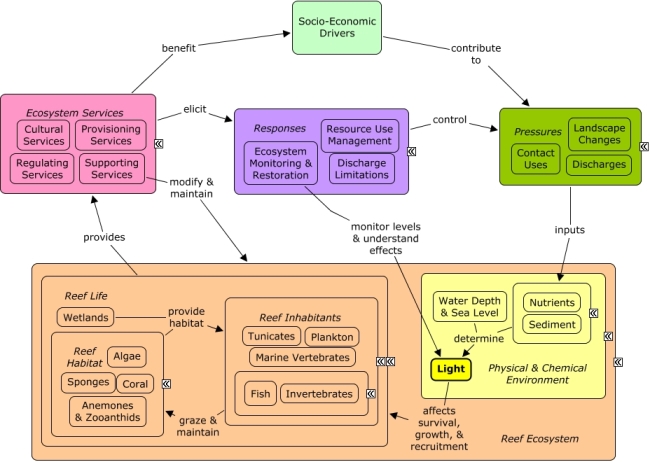ReefLink Database

Light
Light is the level of visible and ultraviolet solar radiation that penetrates the water column.
CMap

CMap Description
Availability of light varies with water depth, and is a key factor distinguishing deep and shallow water communities. Deposition or resuspension of sediment from run-off, dredging or boat movement will affect light availability. Excess nutrients from wastewater discharges or nutrient run-off can also impact light levels. Changes in light can impact the growth of reef species, alter competitive interactions among algae and coral, or alter the behavior of fish and invertebrates. Elevated solar radiation, in concert with elevated sea surface temperatures, may exacerbate coral bleaching. Changes in reef condition can impact the availability of ecosystem services. Many of the same socio-economic sectors that cause pollution benefit indirectly from reef goods and services including fishing and recreational opportunities that contribute to the cultural identity of the local community. Monitoring and scientific research can be used to track light levels, and better understand the effects of light availability on reef life. Discharge limitations and resource-use management can be used to limit discharges and resuspension of sediments and nutrients in coastal waters.Citations
More than 50 citations. Click here to load.
| Citation | Year | Study Location | Study Type | Database Topics |
|---|
Management Options
| Management Option | Description | Sources | Database Topics |
|---|---|---|---|
| Monitor & Research: Water Quality Status and Trends Monitoring | This activity produces long-term, comprehensive information on sanctuary-wide status and trends of water quality parameters. Parameters that should be measured include temperature, salinity, dissolved oxygen, turbidity, relative fluorescence, light attenuation, nutrients, chlorophyll, and alkaline phosphatase activity. | NOAA Marine Sanctuary Program. 2007. Florida Keys National Marine Sanctuary revised management plan. National Ocean Service, Key West, FL. |
Applied Chemicals; Atmospheric Emissions; Calcium Carbonate Deposition; Carbon Storage & Cycling; Chemical Variables; Climate; Climate Regulation; CO2; Discharges; Ecosystem Monitoring & Restoration; Environmental Monitoring & Restoration; Environmental Monitoring, Mapping, & Scientific Research; Light; Nutrient & Contaminant Processing; Nutrients; Ocean Acidity; Physical & Chemical Water Quality Criteria; Physical Variables; Regulating Services; Salinity; Sea Temperatures; Sediment; Supporting Services; Toxics; Waterborne Discharges |
| Waterway Management: Starting slower releases for longer durations from high-intensity rivers in coastal watershed and other methods of reducing sediment transport | Slower releases with longer durations would be an advantage to short, intense releases. This is because current short, high intensity releases from rivers that are in the coastal watershed (like Rio Loco into Lagos Loco and Lucchetti) contributes to additional channel erosion and increase of suspending sediments in the water. | Center for Watershed Protection. 2008. Guanica Bay watershed management plan. |
Agriculture, Aquaculture, & Forestry Policies; Discharge Limitations; Discharges; Drinking Water Supply; Hydrologic Management; Infrastructure; Irrigation; Light; Point Source Discharges; Pressures; Primary Production; Water; Waterborne Discharges |
Laws
| Legal Citation | Purpose of Law | Management Organization | Database Topics |
|---|
